 W
W25 Images of a Man's Passion, or The Passion of a Man is the first wordless novel by Flemish artist Frans Masereel (1889–1972), first published in 1918 under the French title 25 images de la passion d'un homme. The silent story is about a young working-class man who leads a revolt against his employer. The first of dozens of such works by Masereel, the book is considered to be the first wordless novel, a genre that saw its greatest popularity in Europe in the 1920s and 1930s. Masereel followed the book in 1919 with his best-known work, Passionate Journey.
 W
WAge of Reptiles is a series of comics published by Dark Horse Comics, created by Ricardo Delgado, a film and comic book artist who has worked on such films as The Incredibles, Men in Black and Apollo 13.
 W
WThe Ambassador is a short-lived newspaper comic strip created by Otto Soglow, which ran from May 28, 1933 to September 2, 1934.
 W
WThe Arrival by Shaun Tan is a wordless "graphic novel" published by Hodder Children's Books in 2006. The book is 128 pages long and divided into six chapters; it is composed of small, medium, and large panels, and often features pages of full artwork. It features an immigrant's life in an imaginary world that sometimes vaguely resembles our own. Without the use of dialogue or text, Shaun Tan portrays the experience of a father emigrating to a new land. Tan differentiates The Arrival from children's picture books, explaining that there's more emphasis on continuity in texts with multiple frames and panels, and that a "graphic novel" text like his more closely resembles a film making process. Shaun Tan has said he wanted his book to build a kind of empathy in readers: "In Australia, people don't stop to imagine what it's like for some of these refugees. They just see them as a problem once they're here, without thinking about the bigger picture. I don't expect the book to change anybody's opinion about things, but if it at least makes them pause to think, I'll feel as if I've succeeded in something."
 W
WArzach is a comic book collection of four wordless short stories by artist/author Jean 'Moebius' Giraud, which were originally published in the French sci-fi/fantasy comics magazine Métal Hurlant. The stories follow Arzach, a silent warrior who rides a pterodactyl-like creature through a strange, desolate landscape. The imagery and situations in Arzach are often compared to dreams or the subconscious. These stories had an enormous impact on the French comics industry, and the Arzach character is still among Moebius' most famous creations. It can be defined as a pantomime comic, fantasy comics or an experimental comic.
 W
WBoes is a Dutch newspaper gag-a-day comic strip created by Wil Raymakers and Thijs Wilms. It was created in 1980 and spawned a popular anime television series between 1988 and 1991 called Ox Tales in the English-speaking world. The comic managed to outlive the animated adaptation and still continues to appear as a column strip in several Dutch daily and weekly newspapers.
 W
WComix 2000 was an international one-shot independent comic book published in 1999 by L'Association (France) and distributed in the United States by Fantagraphics Books.
 W
WDestiny is the only wordless novel by German artist Otto Nückel. It first appeared in 1926 from the Munich-based publisher Delphin-Verlag. In 190 wordless images the story follows an unnamed woman in a German city in the early 20th century whose life of poverty and misfortune drives her to infanticide, prostitution, and murder.
 W
WFather and Son are cartoon figures created by E. O. Plauen. The pantomime comic depicts a plump, balding father and his son grappling with various everyday situations. The cartoon was a weekly feature in the Berliner Illustrirte Zeitung from 1934 to 1937.
 W
WFerd'nand was a Danish pantomime comic notable for its lack of word balloons and captions and its longevity. It was first published in 1937 and is still published regularly in several countries around the globe.
 W
WFox Bunny Funny is a graphic novel by Andy Hartzell. The book was published in June 2007 by Top Shelf Productions. Through its use of anthropomorphic animals drawn in black and white without the use of word bubbles or text, it conveys themes of desire, violence, and psychological distress.
 W
WFrank is a cartoon character created by American cartoonist Jim Woodring. Frank is a bipedal, bucktoothed animal of uncertain species whom Woodring described as a "generic anthropomorph". The stories and supporting characters appear in a world called the Unifactor.
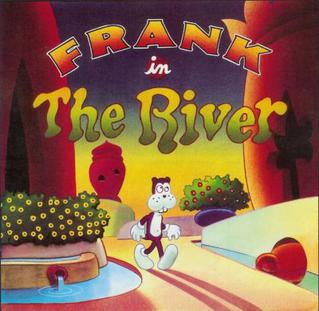 W
WFrank in the River is a 24-page comic story by Jim Woodring.
 W
WGods' Man is a wordless novel by American artist Lynd Ward (1905–1985) published in 1929. In 139 captionless woodblock prints, it tells the Faustian story of an artist who signs away his soul for a magic paintbrush. Gods' Man was the first American wordless novel, and is considered a precursor of the graphic novel, whose development it influenced.
 W
WGon is a Japanese manga series created by Masashi Tanaka. The Gon series features the completely wordless adventures of the irascible, tiny dinosaur and the title character, as he interacts with the natural world, depicted by Tanaka in lush, realistic detail. Gon somehow survived the extinction of his fellow dinosaurs and interacts with paleolithic animals.
 W
WHe Done Her Wrong is a wordless novel written by American cartoonist Milt Gross and published in 1930. It was not as successful as some of Gross's earlier works, notably his book Nize Baby (1926) based on his newspaper comic strips. He Done Her Wrong has been reprinted in recent years and is now recognized as a comic parody of other similar wordless novels of the early 20th century, as well as an important precursor to the modern graphic novel.
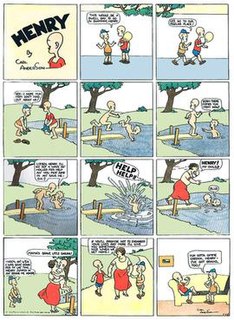 W
WHenry was a comic strip created in 1932 by Carl Thomas Anderson. The title character is a young bald boy who is mute. With the exception of a few early episodes, the comic strip character communicates only through pantomime, a situation which changed when Henry moved into comic books.
 W
WThe Idea is a 1920 wordless novel by Flemish artist Frans Masereel (1889–1972). In eighty-three woodcut prints, the book tells an allegory of a man's idea, which takes the form of a naked woman who goes out into the world; the authorities try to suppress her nakedness, and execute a man who stands up for her. Her image is spread through the mass media, inciting a disruption of the social order. Filmmaker Berthold Bartosch made an animated adaptation in 1932.
 W
WKuri-chan (クリちゃん) is a yonkoma manga series by Susumu Nemoto which ran from October 1, 1951 to March 31, 1965 in the Asahi Shimbun evening edition. Nemoto modeled the main character, Kuri-chan, after his oldest son who was born in 1948. The name of the main character is actually Ken (健), and gets his nickname from his naturally "kuri kuri" hair. The manga is unusual in that, other than the images, it relies almost exclusively on onomotopeia rather than words to tell the story. In that regard it has been classified as a pantomime comic.
 W
WThe Life and Times of Conrad Black is a wordless novel by Canadian artist George Walker, published in 2013.
 W
WThe Little King is a 1934-1975 American gag-a-day comic strip created by Otto Soglow, telling its stories in a style using images and very few words, as in pantomime.
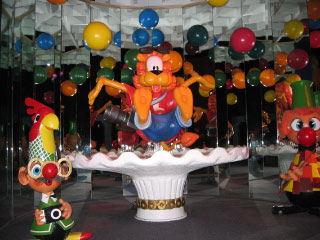 W
WLoeki de Leeuw is a Dutch stop-motion TV animation, broadcast on Dutch public television between 1972 and 2004, and again in 2019. It featured a puppet lion in short sketches usually not longer than five seconds, which appeared as bumpers between commercial breaks. These animated shorts reached iconic status in the Netherlands, but were also broadcast in some other countries like France, the United Kingdom, Austria, Italy, Japan and the United States.
 W
WMadman's Drum is a wordless novel by American artist Lynd Ward (1905–1985), published in 1930. It is the second of Ward's six wordless novels. The 118 wood-engraved images of Madman's Drum tell the story of a slave trader who steals a demon-faced drum from an African he murders, and the consequences for him and his family.
 W
WOld Master Q is a popular Hong Kong manhua created by Alfonso Wong. The cartoon first appeared in the newspapers and magazines in Hong Kong on February 3, 1962, and later serialised in 1964. The comic is still in publication today, and is the oldest Asian comic series in publication.
 W
WOwly is an American children's graphic novel series created since 2004 by Andy Runton and published by Top Shelf Productions.
 W
WPassionate Journey, or My Book of Hours, is a wordless novel of 1919 by Flemish artist Frans Masereel. The story is told in 167 captionless prints, and is the longest and best-selling of the wordless novels Masereel made. It tells of the experiences of an early 20th-century everyman in a modern city.
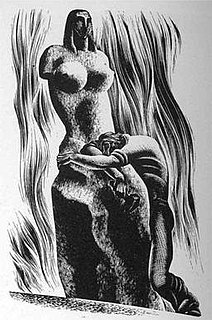 W
WPrelude to a Million Years: A Book of Wood Engravings is a 1933 wordless novel consisting of thirty wood engravings by American artist Lynd Ward (1905–1985). It was the fourth of Ward's six wordless novels, a genre Ward discovered while studying wood engraving in Europe, and delved into under the influence of the works of Frans Masereel and Otto Nückel. The symbol-rich story tells of a sculptor who, in his quest for ideal beauty, neglects the reality of the struggles of his neighbors in the depths of the Great Depression. The engravings are done in a softer Art Deco style in contrast to the German Expressionism-influenced artwork of Ward's earlier works.
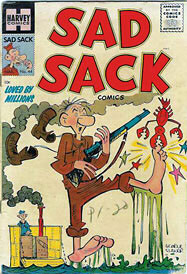 W
WSad Sack is an American comic strip and comic book character created by Sgt. George Baker during World War II. Set in the United States Army, Sad Sack depicted an otherwise unnamed, lowly private experiencing some of the absurdities and humiliations of military life. The title was a euphemistic shortening of the military slang "sad sack of shit", common during World War II. The phrase has come to mean "an inept person" or "inept soldier".
 W
WUne semaine de bonté is a collage novel and artist's book by Max Ernst, first published in 1934. It comprises 182 images created by cutting up and re-organizing illustrations from Victorian encyclopedias and novels.
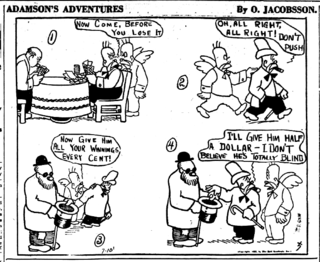 W
WSilent Sam (Adamson) is a Swedish pantomime comic, created by Oscar Jacobsson (1889-1945) in 1920. It has also been published under the name Adamson's Adventures.
 W
WThe Snowman is a wordless children's picture book by English author Raymond Briggs, first published in 1978 by Hamish Hamilton in the United Kingdom, and published by Random House in the United States in November of the same year. The book won a number of awards and was adapted into an animated television film in 1982 which is an annual fixture at Christmas. The book is entirely wordless, and illustrated with only pencil crayons. Briggs said that it was partly inspired by his previous book Fungus the Bogeyman: "For two years I worked on Fungus, buried amongst muck, slime and words, so... I wanted to do something which was clean, pleasant, fresh and wordless and quick."
 W
WSong Without Words: A Book of Engravings on Wood is a wordless novel of 1936 by American artist Lynd Ward (1905–1985). Executed in twenty-one wood engravings, it was the fifth and shortest of the six wordless novels Ward completed, produced while working on the last and longest, Vertigo (1937). The story concerns the anxiety an expectant mother feels over bringing a child into a world under the threat of fascism—anxieties Ward and writer May McNeer were then feeling over McNeer's pregnancy with the couple's second child.
 W
WSouthern Cross is the sole wordless novel by Canadian artist Laurence Hyde (1914–1987). Published in 1951, its 118 wood-engraved images narrate the impact of atomic testing on Pacific islanders. Hyde made the book to express his anger at the US military's nuclear tests in the Bikini Atoll.
 W
WSqueak the Mouse is an Italian black comedy comic strip and later comic book created by artist Massimo Mattioli. The comic was set in a fictional funny animal setting, depicting attempts by its title character, Squeak the Mouse, to outwit a cat who is chasing him. The comic satirizes cartoon series such as Tom and Jerry, taking the content to extreme levels, which includes gory horror violence and explicit sexual content.
 W
WSticky is a book of gay erotic comics written by Dale Lazarov and drawn by Steve MacIsaac.
 W
WThe Strange World of Mr. Mum was a surreal humor comic panel by Irving Phillips which was published from May 5, 1958 to 1974. At its peak, it appeared daily in 180 newspapers in 22 countries. Initially distributed by the Hall Syndicate, it was later handled by the Field Newspaper Syndicate. A Sunday edition began October 4, 1959.
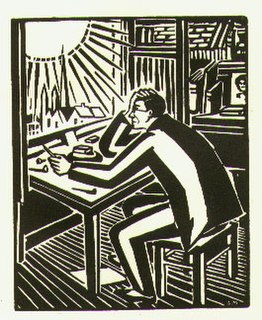 W
WThe Sun is a wordless novel by Flemish artist Frans Masereel (1889–1972), published in 1919. In sixty-three uncaptioned woodcut prints, the book is a contemporary retelling of the Greek myth of Icarus.
 W
WVertigo is a wordless novel by American artist Lynd Ward (1905–1985), published in 1937. In three intertwining parts, the story tells of the effects the Great Depression has on the lives of an elderly industrialist and a young man and woman. Considered his masterpiece, Ward uses the work to express the socialist sympathies of his upbringing; he aimed to present what he called "impersonal social forces" by depicting the individuals whose actions are responsible for those forces.
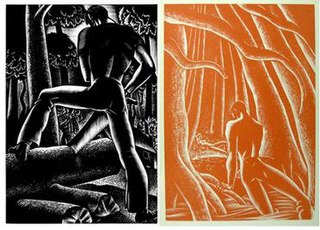 W
WWild Pilgrimage is the third wordless novel of American artist Lynd Ward (1905–1985), published in 1932. It was executed in 108 monochromatic wood engravings, printed alternately in black ink when representing reality and orange to represent the protagonist's fantasies. The story tells of a factory worker who abandons his workplace to seek a free life; on his travels he witnesses a lynching, assaults a farmer's wife, educates himself with a hermit, and upon returning to the factory leads an unsuccessful workers' revolt. The protagonist finds himself battling opposing dualities such as freedom versus responsibility, the individual versus society, and love versus death.